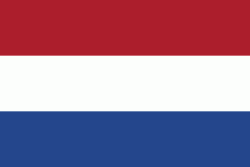Museum Geelvinck-Hinlopen (Geelvinck-Hinlopen Huis)
Museum Geelvinck Hinlopen Huis was situated from its opening 1991 till the end of 2015 in a canal-side mansion, the Geelvinck Hinlopen Huis in Amsterdam, the Netherlands. This patrician mansion, close to the Rembrandtplein, was built for Albert Geelvinck (1647-1693) and Sara Hinlopen (1660-1749), then in an attractive and new laid-out section of the city towards the Amstel. In the year 1687 the couple moved into this double wide house, with storage rooms in the cellar, under the attic and in the warehouse on Keizersgracht 633, now the entrance.
The canal mansion 'Geelvinck Hinlopen Huis' is now closed for the public, because the museum (including the rosarium) has moved to new premises. In Spring 2017 the museum opened its new premises in the historic mansion 'De Wildeman' in Zutphen, but had to close down already by the end of 2019. Today, Museum Geelvinck is located at the country estate 'Kolthoorn House' in Heerde and also has a modest venue at the 'Posthoornkerk' in Amsterdam.
Albert Geelvinck came from the upper class Geelvinck family, who had acquired their wealth through merchant shipping to Spain, Africa, Suriname and the West Indies. Sara Hinlopen came from a family of originally Flemish cloth merchants, private investors and in an early stage involved in the governing the city and the Dutch East India Company. Both families belonged to the regents of Amsterdam. The republican Geelvincks delivered five burgomasters (mayors) in the 17th and 18th century. They too served in the Admiralty of Amsterdam, Dutch West India Company or the Society of Surinam.
Sara became an orphan at the age of six. Then she and her sister Johanna were raised by a stepmother Lucia Wijbrants. Because the cooperation did not work out well, they moved in with Jacob J. Hinlopen, their uncle, in 1672. Keen on leaving the house, she married in 1680 the fifteen-year-older lawyer Albert Geelvinck. A few months before the girls came by lot in the possession of the paintings by Rembrandt, and Gabriel Metsu, collected by their father Jan J. Hinlopen.
Twice Sara Hinlopen became a widow. In 1749 she died at the age of almost 89, but blind. The house, her stakes, her paintings and her books, including the cash money (ƒ 2,50), was divided into lots and went to Nicolaes Geelvinck and his three sisters.
The canal mansion 'Geelvinck Hinlopen Huis' is now closed for the public, because the museum (including the rosarium) has moved to new premises. In Spring 2017 the museum opened its new premises in the historic mansion 'De Wildeman' in Zutphen, but had to close down already by the end of 2019. Today, Museum Geelvinck is located at the country estate 'Kolthoorn House' in Heerde and also has a modest venue at the 'Posthoornkerk' in Amsterdam.
Albert Geelvinck came from the upper class Geelvinck family, who had acquired their wealth through merchant shipping to Spain, Africa, Suriname and the West Indies. Sara Hinlopen came from a family of originally Flemish cloth merchants, private investors and in an early stage involved in the governing the city and the Dutch East India Company. Both families belonged to the regents of Amsterdam. The republican Geelvincks delivered five burgomasters (mayors) in the 17th and 18th century. They too served in the Admiralty of Amsterdam, Dutch West India Company or the Society of Surinam.
Sara became an orphan at the age of six. Then she and her sister Johanna were raised by a stepmother Lucia Wijbrants. Because the cooperation did not work out well, they moved in with Jacob J. Hinlopen, their uncle, in 1672. Keen on leaving the house, she married in 1680 the fifteen-year-older lawyer Albert Geelvinck. A few months before the girls came by lot in the possession of the paintings by Rembrandt, and Gabriel Metsu, collected by their father Jan J. Hinlopen.
Twice Sara Hinlopen became a widow. In 1749 she died at the age of almost 89, but blind. The house, her stakes, her paintings and her books, including the cash money (ƒ 2,50), was divided into lots and went to Nicolaes Geelvinck and his three sisters.
Map - Museum Geelvinck-Hinlopen (Geelvinck-Hinlopen Huis)
Map
Country - Netherlands
 |
 |
The four largest cities in the Netherlands are Amsterdam, Rotterdam, The Hague and Utrecht. Amsterdam is the country's most populous city and the nominal capital. The Hague holds the seat of the States General, Cabinet and Supreme Court. The Port of Rotterdam is the busiest seaport in Europe. Schiphol is the busiest airport in the Netherlands, and the third busiest in Europe. The Netherlands is a founding member of the European Union, Eurozone, G10, NATO, OECD, and WTO, as well as a part of the Schengen Area and the trilateral Benelux Union. It hosts several intergovernmental organisations and international courts, many of which are centred in The Hague.
Currency / Language
| ISO | Currency | Symbol | Significant figures |
|---|---|---|---|
| EUR | Euro | € | 2 |
| ISO | Language |
|---|---|
| NL | Dutch language |
| FY | West Frisian language |















